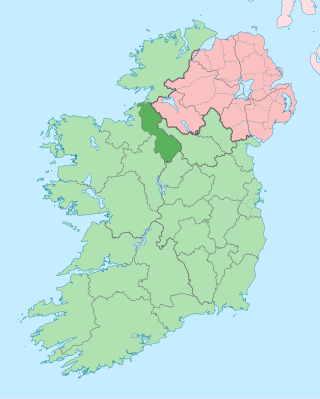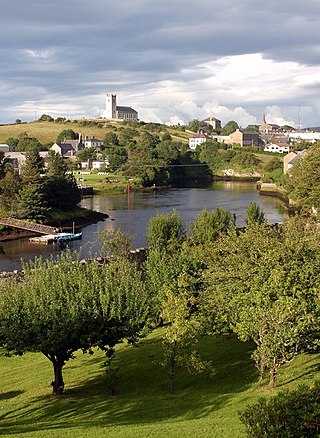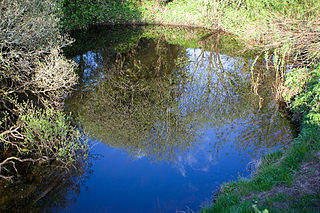
County Fermanagh is one of the thirty-two counties of Ireland, one of the nine counties of Ulster and one of six counties of Northern Ireland

Enniskillen is the largest town in County Fermanagh, Northern Ireland. It is in the middle of the county, between the Upper and Lower sections of Lough Erne. It had a population of 14,086 at the 2011 Census. Enniskillen Castle was built in the 15th century as a stronghold of the Maguires, before coming under English control in the early 17th century. The castle and town were expanded during the Plantation of Ulster. It was the seat of local government for the former Fermanagh District Council, and is the county town of Fermanagh.

County Leitrim is a county in Ireland. It is in the province of Connacht and is part of the Northern and Western Region. It is named after the village of Leitrim. Leitrim County Council is the local authority for the county, which had a population of 35,087 according to the 2022 census.

County Cavan is a county in Ireland. It is in the province of Ulster and is part of the Northern and Western Region. It is named after the town of Cavan and is based on the historic Gaelic territory of East Breffny (Bréifne). Cavan County Council is the local authority for the county, which had a population of 81,201 at the 2022 census.

The River Erne in the northwest of the island of Ireland, is the second-longest river in Ulster, flowing through Northern Ireland and the Republic of Ireland, and forming part of their border.

The N16 road is a national primary road in Ireland. It begins in County Sligo in the northwest of Ireland, and ends at Blacklion, County Cavan, at the border with Northern Ireland, where it becomes the A4 road. At 47.49 kilometres (29.51 mi), The N16 is one of the shorter national primary routes, as it forms only part of a major route from Sligo to Enniskillen and onwards to Belfast.

Glenfarne or Glenfarn is a village in north County Leitrim, Ireland. It is the site of the original Ballroom of Romance, which inspired a short story by William Trevor that was subsequently turned into a television film in a BBC/RTÉ co-production. Glenfarne has a lakeside forest near Lough MacNean. The village is located on the N16 (Sligo–Blacklion) road, 13 km east of Manorhamilton.

Dowra is a village and townland in northwest County Cavan, Ireland. Located in a valley on Lough Allen, it is the first village on, and marks the most uppermost navigable point of, the River Shannon. On one side of its bridge is County Cavan; on the other is County Leitrim. The nucleus of the village is situated on the Cavan side. It is located on the junction of the R200 and R207 regional roads.

Belcoo ( is a small village and townland in County Fermanagh, Northern Ireland, 10 miles from Enniskillen. It is on the County Fermanagh/County Cavan border beside the village of Blacklion in the Republic of Ireland. It had a population of 540 in the 2011 Census. It is situated within the Fermanagh and Omagh District.

Shannon Pot is a pool in the karst landscape in the townland of Derrylahan near Cuilcagh Mountain in County Cavan, Ireland. An aquifer-fed naturally fluctuating pool, it is the traditional source of the River Shannon. It has connections, through the Shannon Cave system, to other pools, notably two in County Fermanagh. The pool itself is about 16 m (52 ft) wide, and has been dived to −14.6 metres (−48 ft). Settlements near the Shannon Pot include Dowra, Blacklion and Glangevlin.
Cathal Buí Mac Giolla Ghunna was an Irish poet.

The A4 is a major east–west road in Northern Ireland. It travels for 69.2 miles from Portadown to Belcoo through County Armagh, County Tyrone and County Fermanagh.

Lough MacNean is a large freshwater lake on the border between Northern Ireland and the Republic of Ireland.

Glangevlin is a village in the northwest of County Cavan, Ireland. It is in the townlands of Gub (Glangevlin) and Tullytiernan, at the junction of the R200 and R207 regional roads. It is surrounded by the Cuilcagh Mountains and borders the counties of Leitrim and Fermanagh. A large stone known as 'Maguire's chair' is deposited on the right hand side of the road, roughly 4 miles from Glangevlin village, so-called because it was supposedly the inauguration site of the Maguire clan in medieval times.

The A46 is a road in County Fermanagh, in Northern Ireland. It forms part of the route from Dublin to Ballyshannon. It stretches 23.6 miles from Enniskillen to Belleek along the southwestern shoreline of Lower Lough Erne.

The Cuilcagh Lakelands Geopark formerly known as the Marble Arch Caves Global Geopark straddles the border between Northern Ireland and the Republic of Ireland. It is centred on the Marble Arch Caves and in 2001 it became one of the first geoparks to be designated in Europe.
Neven Maguire is an Irish celebrity chef and television personality from Blacklion, County Cavan. He is also the head chef and proprietor of the MacNean House and Restaurant.
The Cavan Way is a long-distance trail in County Cavan, Ireland. It is 22 kilometres long and begins in Blacklion and ends in Dowra. It is typically completed in one day. It is designated as a National Waymarked Trail by the National Trails Office of the Irish Sports Council and is managed by Cavan County Council. The trail was devised by a local man, Harold Johnston, and set up by the Blacklion Community Council and the Cavan County Development Team between 1984 and 1985.
Tomás Óg Mág Samhradháin was chief of the McGovern Clan and Baron or Lord of Tullyhaw barony, County Cavan from 1584 until his death at the end of the 16th century.
Brian Magauran, the Fourth, b.1592 was chief of the McGovern Clan and Baron or Lord of Tullyhaw barony, County Cavan from 1622 until his death some time after 1628.


















